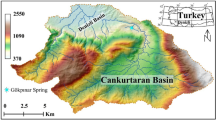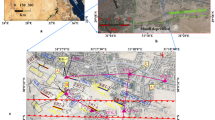Abstract
The Ophiolitic complex of the study area oriented in N–S direction, having moderate to steep slopes of the topography and characterized by strong heterogeneity, repetitive deformations and multiple intrusions. Ophiolites of the study area encompass the major groundwater-bearing zones. Generally, these formations have shallower fractured aquifers of a thickness 30–45 m and sometimes due to deep tensile fractures the thickness of aquifer exceeds more than 60 m with a considerable groundwater yield. A joint venture of satellite remote sensing, geoelectrical resistivity and ground penetrating radar (GPR) techniques has been used to assess the groundwater potential of the fractured Ophiolites. The interpreted resistivity inversion model and GPR results were incorporated with borehole lithologs for their subsurface properties and structural variations. The integration of using multiple techniques has increased the accuracy of interpretation, and thus conflated results significantly rendered the existence of weathered and fractured zone having hydrogeological importance. Based on the parameters, viz., geoelectrical properties of layers, reflection configuration, thickness of weathered and fractured aquifer zone, a typical aquifer model for the study area that contains various layers and subtle structural variation has been developed. Further, the derived integrated geophysical data also detail on various lithological characteristics and advances the understanding about aquifer systems of fractured Ophiolites and the distribution of groundwater in fractures.












Similar content being viewed by others
References
Annan AP (1997) Ground penetrating radar workshop notes. Sensors & Software Inc, Mississauga
Asprion U, Aigner T (1997) Aquifer architecture analysis using ground-penetrating radar: Triassic and Quaternary examples (S. Germany). Environ Geol 31:66–75
Bakliwal PC (1978) Tectonic interpretation from lineament analysis using photogeophysical techniques of Ranthamber fort areas, Rajasthan, India. Third regional conference on geology and mineral resource of Southeast Asia, p 129–131
Balaji S, Ramasamy SM (1993) Aid of remote sensing in mapping geofractures of environmental significance in Tamil Nadu. J Ind Soc Remote Sen 21:109–118
Balaji S, Ramasamy SM (2005) Remote sensing and resistivity image for the tectonic analysis of Biligirirangan region of Peninsular India. Geocarto Int 20:55–61
Barker RD, White CC, Houston JFT (1992) Borehole sitting in an African accelerated drought relief project. In: Wright EP, Burgess WG (eds) Hydrogeology of crystalline basement aquifers in Africa. Geol Soc, London, pp 183–201
Bayer P, Huggenberger P, Renard P et al (2011) Three-dimensional high resolution fluvio-glacial aquifer analog: part 1: field study. J Hydrol 405:1–9
Beres MJ, Haeni FP (1991) Application of ground-penetrating-radar methods in hydrogeologic studies. GroundWater 29:375–386
Bhosle B, Parkash B, Awasthi AK et al (2007) Remote sensing-GIS and GPR studies of two active faults, Western Gangetic Plains, India. J Appl Geophys 61:155–164
Bian Z, Lei S, Inyang HI et al (2009) Integrated method of RS and GPR for monitoring the changes in the soil moisture and groundwater environment due to underground coal mining. Environ Geol 57:131–142
Bowling JC, Rodriguez AB, Harry DL et al (2005) Delineating alluvial aquifer heterogeneity using resistivity and GPR data. GroundWater 43:890–903
Brockmann CE, Fernandez A, Ballon R, et al. (1977) Analysis of geological structures based on landsat 1 images. In: Smith WL (ed) Remote sensing applications for mineral exploration. 292–317
Busby JP, Merritt JW (1999) Quaternary deformation mapping with ground penetrating radar. J Appl Geophys 41:75–91
CGWB (2010) Approach paper on ground water quality issues in Islands (Andaman and Nicobar and Lakshadweep). Government of India, New Delhi 69
Davis JL, Annan AP (1989) Ground penetrating radar for high-resolution mapping of soil and rock stratigraphy. Geophys Prospect 37:531–551
Dhakate R, Singh VS, Negi BC et al (2008) Geomorphological and geophysical approach for locating favorable groundwater zones in granitic terrain, Andhra Pradesh, India. J Environ Manag 88:1373–1383
Doetsch J, Linde N, Pessognelli M et al (2012) Constraining 3-D electrical resistance tomography with GPR reflection data for improved aquifer characterization. J Appl Geophys 78:68–76
Doolittle JA, Jenkinson B, Hopkins D et al (2006) Hydropedological investigations with ground-penetrating radar (GPR): estimating water-table depths and local ground-water flow pattern in areas of coarse-textured soils. Geoderma 131:317–329
Gaber A, Koch M, Griesh MH et al (2011) SAR remote sensing of buried faults: implications for groundwater exploration in the Western Desert of Egypt. Sens Imag 12:133–151
Goodman D, Piro S (2013) GPR remote sensing in archaeology. Springer, Berlin 244
Ingemar L (1984) Ground water in hard rocks. Project 8.6 ed. UNESCO, Paris, France, p 228
Israil M, Al-hadithi M, Singhal DC (2006) Application of a resistivity survey and geographical information system (GIS) analysis for hydrogeological zoning of a piedmont area, Himalayan foothill region, India. Hydrogeol J 14:753–759
Khalil MH (2010) Hydro-geophysical configuration for the quaternary aquifer of Nuweiba alluvial fan. J Environ Eng Geophys (JEEG) 15:77–90
Koch M, Gaber A, Burkholder B et al (2012) Development of new water resources in Egypt with earth observation data: opportunities and challenges. Int J Environ Sustain 1:1–11
Kumar A, Shetler D, Dennyson KA (2009) Bore well survey report. Andaman water project. Emmanuel Hospital Association, New Delhi 38
Lapen DR, Moorman BJ, Price JS (1996) Using ground-penetrating radar to delineate subsurface features along a wetland catena. Soil Sci Soc Am J 60:923–931
Mallik SB, Bhattacharya DC, Nag SK (1983) Behaviour of fractures in hard rocks—a study by surface geology and radial VES method. Geoexploration 21:181–189
Maury S (2012) Strategies on groundwater resources management and development of South Andaman Islands, India—An Extensive approach of remote sensing and ground penetrating radar (GPR). National Conference on Quest for Advancements in Civil Engineering (QACE’ 12). SRM University, Chennai, 506–514
Maury S (2014) Spatial modeling of ground water potential in parts of South Andaman Island, India—an integrated approach of remote sensing and geophysical techniques. Department of Disaster Management, Pondicherry University, Pudducherry 246
Maury S, Balaji S (2014a) Geoelectrical method in the investigation of groundwater resource and related issues in Ophiolite and Flysch formations of Port Blair, Andaman Island, India. Environ Earth Sci 71:183–199
Maury S, Balaji S (2014b) An integrated ground penetrating radar (GPR) and geoelectric methods for deciphering potential ground water aquifers of beodnabad catchment, South Andaman Island. In: Roy I (ed) Workshop on conservation of water resources in Andaman & Nicobar Islands: issue and challenges. CGWB, Kolkata, pp 28–35
Mayer PJL (1984) A surface resistivity method for measuring hydrologic characteristics of jointed formations. 8901. U.S. Bureau of Mines, 45
McDowell PW (1979) Geophysical mapping of water filled fracture zones in rocks. Int Assoc Eng Geol Bull 19:258–264
McNeill JD (1980) Electrical conductivity of soils and rocks. Geonics Limited, Mississauga (technical note TN-5)
Medeiros WE, de Lima OAL (1990) A geoelectrical investigation for ground water in crystalline terrains of Central Bahia, Brazil. GroundWater 28:518–523
Meijerink AMJ, Bannert D, Batelaan O, et al. (2007) Remote Sensing Applications to Groundwater. In: Rubio M (ed) IHP-VI, Series on Groundwater No.16 ed. Paris, France: UNESCO, 311
Mohammad HM (2004) Integrating GPR and geostatistical techniques to map the spatial extent of a shallow groundwater system. J Geophys Eng 1:56–62
Moore GF, Curray JR and Emmel FJ. (1982) Sedimentation in the Sunda trench and forearc region. In: Trench-Forearc geology: sedimentation and tectonics on Modern and ancient active plate margins. Geological Society of London 10: 245–258
Mukhopadhyay B, Fnais M, Mukhopadhyay M et al (2010) Seismic cluster analysis for the Burmese-Andaman and West Sunda Arc: insight into subduction kinematics and seismic potentiality. Geomat Nat Hazards Risk 1:283–314
Nascimento da Silva CC, Medeiros WE, Jardim de Sa EF et al (2004) Resistivity and ground-penetrating radar images of fractures in a crystalline aquifer: a case study in Caicara farm—NE Brazil. J Appl Geophys 56:295–307
Nolan BT, Campbell DL, Senterfit RM (1998) Depth of the base of the Jackson aquifer, based on geophysical exploration, southern Jackson Hole, Wyoming, USA. Hydrogeol J 6:374–382
Orellana E, Money HM (1966) Master tables and curves for vertical electrical sounding over layered structures. Interciencia, Madrid (Costanilla de Los Angeles, 15)
Pal T, Chakraborty PP, Gupta TD et al (2003) Geodynamic evolution of the outer arc-forearc belt in the Andaman Islands, the central part of the Burma-java subduction complex. Geol Mag 140:289–307
Park YH, Doh SJ, Yun ST (2007) Geoelectric resistivity sounding of riverside alluvial aquifer in an agricultural area at Buyeo, Geum River watershed, Korea: an application to groundwater contamination study. Environ Geol 53:849–859
Porsani JL, Elis VR, Hiodo FY (2004) Geophysical investigations for the characterization of fractured rock aquifers in Itu, SE Brazil. J Appl Geophys 57:119–128
Raju NJ, Reddy TVK (1998) Fracture pattern and electrical resistivity studies for groundwater exploration. Environ Geol 34:175–182
Rubin LA, Fowler JC (1978) Ground-probing radar for delineation of rock fractures. Eng Geol 12:163–170
Sandberg SK, Slater LD, Versteeg R (2002) An integrated geophysical investigation of the hydrogeology of an anisotropic unconfined aquifer. J Hydrol 267:227–243
Shahid S, Nath SK (2002) GIS integration of remote sensing and electrical sounding data for hydrogeological exploration. J Spat Hydrol 2:1–12
Singh VS, Nandakumar MV, Sarma MRK et al (2005) Changes in groundwater regime at Neill Island (South Andaman) due to earthquake and tsunami. Curr Sci 88:1984–1987
Srivastava PK, Bhattacharya AK (2006) Groundwater assessment through an integrated approach using remote sensing, GIS and resistivity techniques: a case study from a hard rock terrain. Int J Remote Sens 27:4599–4620
Srivastava VK, Giri DN, Bharadwaj P (2012) Study and mapping of ground water prospect using remote sensing, GIS and geoelectrical resistivity techniques—a case study of Dhanbad district, Jharkhand, India. J Ind Geophys Union 16:55–63
Ulriksen CPF (1982) Application of impulse radar to civil engineering. Lund University of Technology, Lund (republished by Geophysical Survey Systems Inc., Hudson, NH)
Zohdy AAR (1969) The use of Schlumberger and equatorial soundings in groundwater investigations near El Paso, Texas. Geophysics 34:713–728
Acknowledgments
This work was accomplished under the Ph.D. research grant (PU/CE/E9/PHD/2009-10) funded by Pondicherry University to the first author. The first author is thankful to Geo Foundation and Structures (P) Ltd, Port Blair, Military Engineering Service, Port Blair, for providing him a great opportunity to work on some pivotal projects and experience with these organizations immensely improved this research work.
Author information
Authors and Affiliations
Corresponding author
Ethics declarations
Conflict of interest
We do not have any conflict of interest.
Rights and permissions
About this article
Cite this article
Maury, S., Tiwari, R.K. & Balaji, S. Joint application of satellite remote sensing, ground penetrating radar (GPR) and resistivity techniques for targeting ground water in fractured Ophiolites of South Andaman Island, India. Environ Earth Sci 75, 237 (2016). https://doi.org/10.1007/s12665-015-5007-1
Received:
Accepted:
Published:
DOI: https://doi.org/10.1007/s12665-015-5007-1




